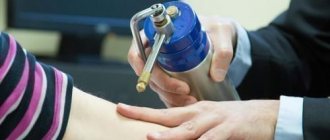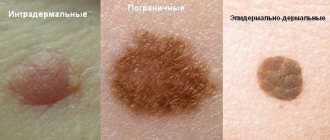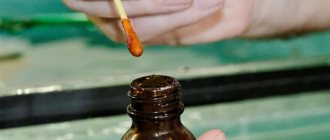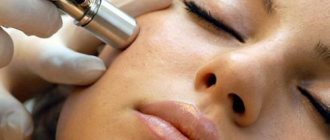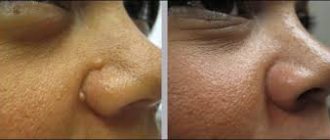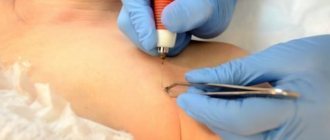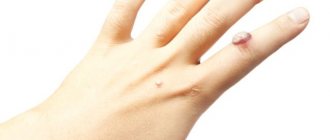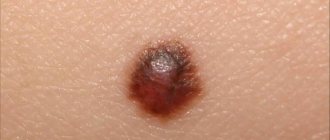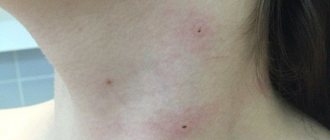With a decrease in the protective functions of the immune system, a person becomes vulnerable to infection with viral infections. All of them lead to the development of some kind of disease. One of these is the appearance of warts on the skin. If you find them, you should immediately go to the doctor, especially if they cause discomfort.
During your consultation with the doctor, the most suitable type of cryosurgery for wart removal will be selected. Before agreeing to one or another method of eliminating tumors, you should find out everything about the most popular method - cauterization with liquid nitrogen.
What is cryosurgery
This is a surgical intervention that allows you to remove benign and malignant tumors on the skin of the face and body of a person. The operation is performed using different methods. In modern medicine, the most popular method is using liquid nitrogen. The procedure is divided into cryotherapy and cryodestruction.
Each of them involves the quick and easy removal of warts and other types of tumors. Thanks to the use of the latest technologies and high-quality equipment, the operation under the influence of liquid nitrogen takes place without side effects or complications. That is why many people are increasingly choosing this method when they think about removing growths from the body. You can cauterize a wart with liquid nitrogen at any time of the year. There is no need to go through any preparatory procedures. You just need to come to the doctor for a consultation.
Conditions in which it is better to postpone wart removal with liquid nitrogen
- exacerbation of any systemic chronic disease - viral, bacterial, autoimmune. This could be bronchitis, herpes (labial and genital), rheumatoid arthritis, etc. During this period, any surgical procedures are not indicated. An exception may be the clearly dangerous symptoms of a wart, described in the last paragraph of the indications;
- acute viral disease accompanied by fever;
- open wound near the affected area;
- severe arterial hypertension. In this case, consultation and permission for manipulation from a cardiologist is necessary;
The essence of the technique
Cryodestruction is an operation by which tumors are destroyed under the influence of very low temperatures. It is often called the deep freezing technique. Treatment of warts with nitrogen occurs at temperatures from -100 to -180 degrees Celsius. This leads to rapid death of the cellular composition of the viral infection. After using nitrogen, the warts die off and the skin is completely cleansed.
Cryotherapy is a more gentle treatment of low temperatures from -40 to -60 degrees. This method of removing warts with liquid nitrogen is used for small growths that most often appear in children. The entire session takes no more than one minute, and the cauterization itself takes about 30 seconds.
Cryotherapy can be performed with or without local anesthesia. Based on the reviews, we can conclude that the procedure is almost painless. It is allowed to cauterize a wart with liquid nitrogen only after examination by a dermatologist and oncologist. Therefore, before making an appointment to remove the tumor, you must visit these doctors.
The essence and technique of the procedure
Often they try to remove warts using folk remedies such as celandine, vinegar, chalk or onion juice. However, these methods do not always lead to the desired results. Attempts to cut off a wart, although quite common, are completely ineffective.
Moreover, such tactics entail serious consequences, the elimination of which may require much more effort and time than removing the wart itself.
In addition, as noted earlier, it is impossible to remove a wart without removing the root, and cutting off its upper part will not solve the problem.
How does nitrogen work?
Of course, you can try to cauterize a small, recently formed growth with the caustic juice of celandine, sometimes this is enough, but the spine is usually a rather large formation, protected by rough skin, with a deep root. Therefore, the spine is most often removed with liquid nitrogen. This method is also called cryodestruction.
During the procedure, the wart is exposed to a certain substance - liquid nitrogen, which leads to the destruction of the growth tissue throughout its entire thickness. Thus, the spine is destroyed along with the root and subsequently falls off.
The procedure is quite effective and relatively short-lived. After removing a wart using cryodestruction, there are no scars left. Despite many advantages, this method has disadvantages:
- some pain;
- sometimes the need for repeated implementation;
- recovery period that limits movement (it hurts to step on the foot);
- the need to care for the treated growth.
If the thorn is large and has a deep root, removing it with liquid nitrogen may take several months. In addition, there are contraindications to the use of this method, for example:
- any infectious diseases and inflammatory processes;
- high blood pressure;
- pregnancy;
- allergic reactions, rashes, itching in the area of removal;
- vasospasm, etc.
In any case, the decision to carry out the procedure is made by the doctor, having assessed all possible risks and consequences.
Indications for the procedure
After consultation with a specialist, a cryotherapy or cryodestruction procedure may be prescribed. Indications for each of them include:
- The appearance of growths that progress in growth and size.
- The presence of neoplasms in open skin areas.
- Feeling of itching and pain in the area where the growth is localized.
- Loss of the structure of the neoplasm (cracks, bleeding, ruptures).
- Growths in the groin area and on the genitals.
- Protruding warts that are easy to touch in everyday life.
The above discomfort is an indication for urgent removal of growths. Warts do not have to be new. A huge number of people turn to doctors to remove formations that have tormented them for several years.
Some types of warts appear in childhood. If they are not removed in time, this can provoke the development of serious diseases. Some of them may well lead to fatal events. Therefore, you need to try to cauterize the warts with liquid nitrogen as soon as possible and forget about them forever.
Methods for treating plantar growths
Papillomavirus and the neoplasms it causes have been studied quite well. Therefore, there are a sufficient number of methods for getting rid of such a nuisance as growths on the foot. All these methods can be divided into three categories:
- Radical removal in the clinic;
- Medicinal burning at home;
- Traditional methods of treatment.
Many people are afraid of medical manipulations, preferring traditional recipes or home treatment using pharmaceutical drugs. Most patients consider home removal of tumors less traumatic and painful.
However, cauterization of spines with pharmaceutical preparations that contain aggressive alkalis or acids is a risky undertaking that requires careful and strict adherence to the instructions. Otherwise, consequences in the form of burns and pain cannot be avoided. In addition, the effectiveness of such treatment cannot be compared with the removal of thorn in a specialized clinic staffed by professionals who value their reputation.
Important! Self-medication without clarifying the diagnosis increases the risk of transformation of the growth into an oncological neoplasm.
You should consult a doctor immediately if:
- The spine is painful to touch;
- Discomfort (itching or burning) occurs in the damaged area;
- The growth begins to grow sharply and changes shape;
- Subsidiary neoplasms appear;
- The wart has been injured;
- Spores or pus are released from the damaged area.
Contraindications to the procedure
The modern method of cauterizing tumors with liquid nitrogen has contraindications. These include the following conditions:
These contraindications are the main ones. In addition to them, pregnancy, breastfeeding, as well as the individual characteristics of the patient should be taken into account.
Description of the procedure
Only a dermatologist can cauterize a wart with liquid nitrogen. Before starting the session, the doctor injects an anesthetic or treats the skin with a special anesthetic ointment. The patient may refuse anesthesia. In this case, the procedure for cauterizing the wart is done without it. After the painkiller takes effect, the dermatologist begins the operation.
For cauterization, the doctor uses a wooden stick with a cotton swab wrapped around the tip. Some clinics have at their disposal a special cryoprobe that emits liquid nitrogen onto an area of skin directly from the reservoir itself. Liquid nitrogen cylinders are always maintained at the same temperature. A wooden stick is dipped into a tank of nitrogen and then quickly pressed against the wart. The cotton swab should be slightly wider than the diameter of the tumor.
One touch should not last more than 30 seconds. The active substance evaporates quite quickly. Therefore, applications to the wart can be repeated several times. The doctor determines how many cauterizations are required. It all depends on the size of the tumor and its thickness. However, you can cauterize the growth with liquid nitrogen in one session.
How is the procedure performed?
Now we will tell you how to remove warts with liquid nitrogen. To carry out cryodestruction you need a special applicator. This is a special wooden stick 250-300 mm long with a cotton tip. In addition, for freezing you may need a cryoapplicator with special tips that differ in shape and size. Essentially, it is a reservoir for liquid nitrogen.
Treatment of warts is carried out by deep freezing them. To do this, a direct effect is carried out on pathological tissues with slight pressure for several seconds (10-40).
Cauterization of warts with liquid nitrogen is carried out after the following preliminary preparation of the skin:
- First, the skin is treated with an antiseptic composition;
- Next, a gel or cream is applied to the new formation to soften its surface so that liquid nitrogen can penetrate as deeply as possible into its structure;
- Next, local anesthesia is performed. A special cream, aerosol or injection may be used.
After this, you can cauterize the warts. To do this, apply an applicator with a reservoir for liquid nitrogen to the formation. With slight pressure on the applicator, cryogenic liquid comes out and freezes the growth. After this, the formation becomes very dense and white. Then a bubble with serous or hemorrhagic fluid forms. It dissolves on its own within a week, and a dry crust forms in its place. After 7-10 days it separates itself. At first, a pinkish spot remains in this place, which also goes away.
Surgitron device: principle of operation and areas of application of the radioknife
Removing a plantar wart with liquid nitrogen is more painful because the growth requires strong applicator pressure and longer exposure to liquid nitrogen. A removed plantar wart leads to a long process of disability, since stepping on the removal site is painful for two to three weeks. Often, such neoplasms require about 3-4 treatments, which are carried out every three days. Sometimes treatment can take six months.
If a wart was removed with liquid nitrogen, the consequences may be as follows:
- Significant peeling of the skin can cause inconvenience. This is observed when affecting large areas of the epidermis.
- Sometimes pigment spots remain after the removal procedure. However, they may go away within a couple of months as the skin regenerates.
- If the intensity and time of exposure are incorrectly calculated, a severe burn can result, the consequence of which will be a large blister and a scar for life.
Features of wart removal
After the procedure, the growth begins to fade, gradually acquiring a whitish color. Cryodestruction is considered successfully completed after the wound site is covered with a small “fluff”. Swelling may appear at the cauterization site. This phenomenon is considered normal and should not cause any concern.
to cauterize a wart with liquid nitrogen at home. Therefore, you should not believe the advertising promises of scammers who may sell tools for removing growths. Surgery should always be performed by a qualified dermatologist.
If the warts are very deep, the procedure may not be limited to one session. In this case, the doctor will draw up a schedule according to which it will be necessary to continue removing the tumors. Sometimes people take up to six months to get rid of plantar growths. Whether it is possible to cauterize warts with liquid nitrogen, only a doctor can answer. Much depends on their type, color, as well as the state of human health.
Benefits of cauterization with liquid nitrogen
This technique has many undeniable advantages. Among them are the following:
Almost every patient who decides to undergo cryotherapy asks the question: is it painful to burn a wart with liquid nitrogen or not? Any dermatologist will answer that the procedure is not painful. However, you should prepare for unpleasant sensations. Fortunately, the cauterization itself only lasts a few seconds. Therefore, you don’t have to worry about possible pain.
The importance of caring for the growth after the removal procedure, what happens to the wound?
After the nitrogen cauterization procedure, it is necessary to understand the importance of wound care. The skin was seriously damaged. You should follow a number of certain rules, thanks to which you will minimize the occurrence of negative consequences.
Daily care will ensure faster healing of the wound. If you neglect the principles of care after cauterization, the healing process of the wound will proceed much more slowly.
After cauterization, the skin will turn red within a few minutes. The next morning, sometimes some patients develop a blister with fluid inside. The bubble should not be touched; it will go away on its own.
Possible consequences
This cauterization technique also has unpleasant consequences. Of course, a lot is decided by the clinic, where you can cauterize the wart with liquid nitrogen. After all, it is the qualifications of doctors that determine the final quality of the procedure. The negative points include the following:
This is where the disadvantages of cryotherapy end. Despite the small list of negative aspects, cauterization with liquid nitrogen is in great demand. The main thing is to choose an experienced and qualified doctor. A good result will depend on it. If you take a responsible approach to where to cauterize the wart with liquid nitrogen, you don’t have to worry about the consequences of the procedure.
Skin care after cauterization with nitrogen
After a session of cauterization of warts, it is necessary to follow a certain regime that will speed up the process of skin regeneration. While the wound is healing, you should not do the following:
After the wart has been cauterized with liquid nitrogen and a blister has formed, it is necessary to treat the wound with a disinfectant. To do this, you can use salicylic alcohol or Fukortsin.
A few days after the procedure, the blister becomes covered with a dry crust. You can't tear it off. It should fall off on its own. After it, the skin begins to actively regenerate. The wound healing process usually does not exceed 10 days.
What is better to remove warts - laser or nitrogen?
When deciding to remove papillomas with liquid nitrogen or laser, it is necessary to take into account the individual characteristics of your body.
Indications for removal of papillomas using both methods
Methods for removing papillomas using laser and liquid nitrogen have common indications:
- formations of a benign nature;
- medium or small single growths;
- warts located on areas of the skin on the body, on the arms, legs, shoulders, subject to mechanical stress.
In these cases, it does not matter what is better to remove the wart - with a laser or nitrogen. You just need to do it in a timely manner.
Contraindications for operations
There are absolute contraindications for both procedures:
- infectious diseases, including herpes, in the active stage;
- chronic pathologies in the acute stage;
- high blood pressure;
- oncological diseases;
- poor quality papilloma;
- period of pregnancy or lactation;
- diabetes.
Both methods are contraindicated if it is necessary not only to remove the tumor, but also to conduct a histological examination, since with laser coagulation and cauterization with nitrogen, the body of the wart is completely destroyed.
The use of a laser is undesirable if the patient is allergic to photoexposure and anesthesia. The method is inappropriate for small multiple superficial papillomas.
Removing warts with liquid nitrogen is not recommended in case of increased cold sensitivity, epilepsy, the presence of an inflammatory process and irritation of the skin around the tumor. The method is not suitable for removing warts on the face, eyelids, armpits, and intimate places, since the skin in these areas is extremely sensitive.
Side effects
After removal of a tumor using laser coagulation, the risk of side effects is extremely low. After the operation, a sterile crust remains, which disappears after a few days. If the rules of wound care are violated, fever, pain in the wound, and bleeding may occur.
If liquid nitrogen is used, redness and swelling will appear on the skin after thawing the frozen area. In the case of a hairy area of skin, local death of hair follicles and hair loss are possible. During the procedure, a blister is formed under the base of the wart, which opens on its own within 3-4 days, or the doctor releases its contents through a puncture. Complete tissue regeneration occurs within 7-14 days. If the rules of care are violated, a deep wound up to 1.5 cm in diameter may form. Darkening or pallor of the skin is also possible, and a scar may remain at the site of exposure. The risk of scarring is higher when removing large warts.
Is preparation necessary?
Before removing skin warts by any method, it is necessary to undergo an examination and a histology test to exclude the malignant nature of the papilloma. In this case, salon procedures are unacceptable. You also need to make sure there are no contraindications. If there are diseases in the acute stage, treatment is required.
Before removing papilloma using laser coagulation, you should refrain from visiting a solarium, sunbathing, or exposing the skin to chemicals. Immediately before the procedure, it is necessary to remove cosmetics, remove jewelry that comes into contact with the papilloma or will interfere with the operation. After this, the doctor performs anesthesia and begins to remove the growth.
Cryodestruction does not require special preparation. When removing a large wart, anesthesia may be required.
Features of the recovery period
The duration of the recovery period varies depending on how to remove papillomas - by freezing or laser.
Laser coagulation has the shortest recovery period – 10-14 days. In place of the papule, a small depression is formed, covered with a crust, under which the skin healing processes take place. The crust should not be combed, wetted, exposed to cosmetics, or kept in the open sun. For two weeks after surgery, it is not advisable to use scrubs, alcohol solutions, or excessively hot water when caring for the skin. Antiseptic agents are prescribed to treat the wound.
The recovery period after cryodestruction lasts from two weeks to a month, depending on the characteristics of the body. In the first 6-24 hours, a bubble with ichor forms under the wart, which cannot be opened. Within a week, it bursts on its own, and in its place a crust appears, under which the wound heals. After 10-12 days, the old cells die off completely, the crust falls off and a pink mark remains, which soon also disappears. Sometimes this process takes 1.5 months. In the first 3 days, the skin of the blister should not be wetted. In the first 6-10 days, it is forbidden to use creams and decorative cosmetics, be in direct sunlight, change the bandage applied by the doctor, or pick off the scab.
The regeneration process can be accelerated by using hydrocortisone ointment (as prescribed by a doctor).
Price policy
The cost of removing a wart with a laser costs an average of 200 rubles per 1 mm of diameter. Removal is performed under local anesthesia, the cost of which is calculated separately. To remove the growth, only one procedure is required.
The cost of removing a wart with liquid nitrogen costs on average 100 rubles per 1 mm of diameter. However, large or complex tumors may require repeated treatment sessions.
Disadvantages of methods
The main disadvantages of laser therapy:
- high price for the procedure;
- local anesthesia can lead to the development of adverse reactions - dizziness, changes in blood pressure, drowsiness, fatigue.
The main disadvantages of cryodestruction:
- uncontrolled depth of impact, which requires repeated sessions;
- long and painful rehabilitation period;
- discomfort when treating a bubble or wound.
The risk of scar formation, inflammation and wound suppuration with cryodestruction is higher than with laser coagulation. Both methods do not allow sample collection for subsequent histological examination.
Both methods only get rid of the external manifestations of the papillomatosis virus. If they are not combined with systemic treatment, neoplasms may reappear, including at the site of removed ones.
